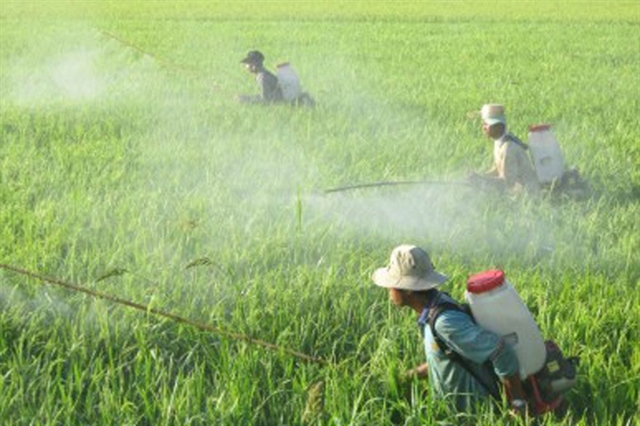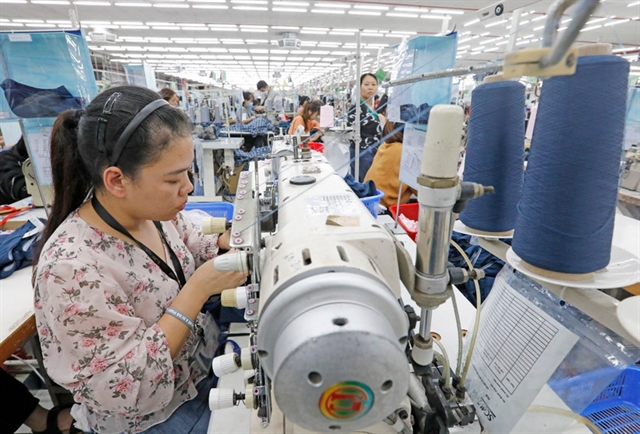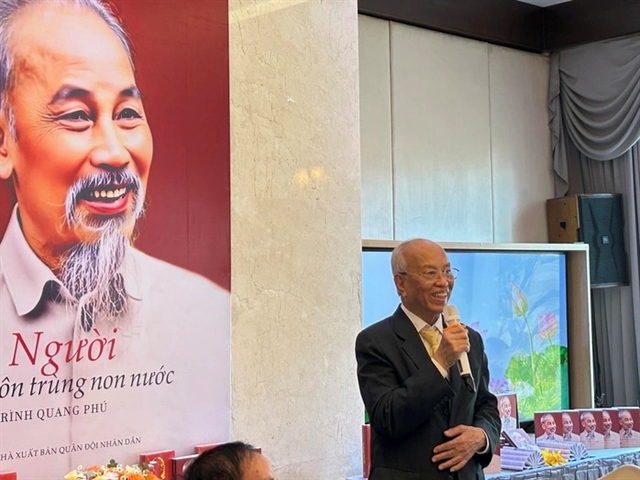 Features
Features

Traditional costumes made with sophisticated sewing, embroidering and decorating techniques are more in the public eye than ever as they are featured in more films and television shows.
By Minh Thu
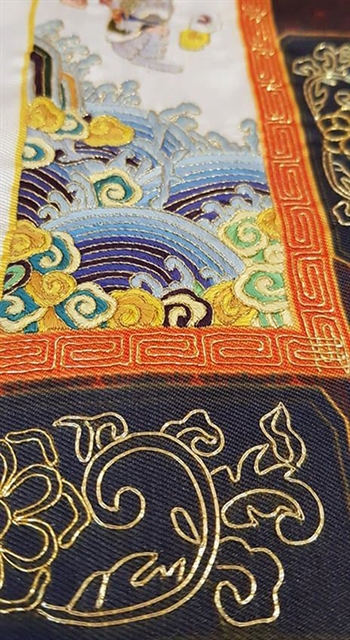
|
| A wave pattern hand-embroidered on a royal costume in colourful blue and gold threads. Photo courtesy of Ỷ Vân Hiên |
Traditional costumes made with sophisticated sewing, embroidering and decorating techniques are more in the public eye than ever as they are featured in more films and television shows.
A TV series directed by Huỳnh Tuấn Anh recently made a stir as the most expensive and impressive project focusing on Vietnamese feudalism and royal families.
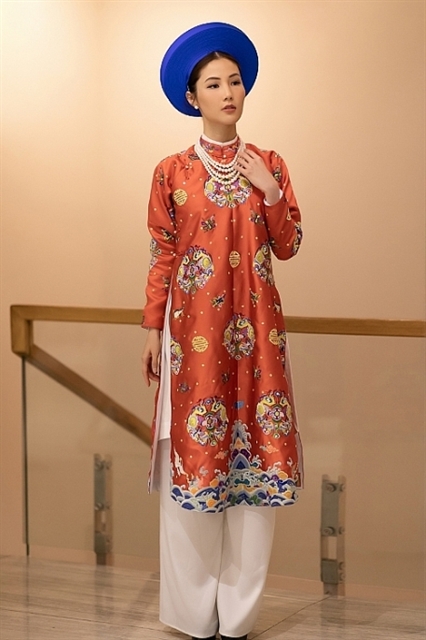
|
| Actress Diễm My shows off one of the costumes worn by her character, Queen Lệ Thiên Anh, in Phượng Khấu. Photo courtesy of Ỷ Vân Hiên |

|
| One of the highlights of the exhibition was the nhật bình dress of Princess Mỹ Lương, sister of King Thành Thái (1879-1954). Photo vov.vn |
Though the 18-episode series Phượng Khấu (The Queen’s Robe Button Engraved with an Image of a Phoenix) will not premiere until next year, it has already attracted attention from the public and experts because it reveals untold stories from the royal family of the Nguyễn Dynasty (1802-1945). It is inspired by history but contains many imaginative and fictional details.
The project features Queen Từ Dụ, whose real name was Phạm Thị Hằng. She helped her son become King Tự Đức (1829-1883) before he enjoyed the longest reign of any monarch of the Nguyễn Dynasty, from 1848 to 1883.
The series focuses on the life of Từ Dụ between 1840 and 1847 when she was a concubine of King Thiệu Trị (1807-1847), the third emperor of the Nguyễn Dynasty.
Much of the series is being shot at various places in the former capital city of Huế. Other indoor scenes are being produced at a studio in HCM City with furniture and architecture designed in an authentic royal style.
Dozens of historians and cultural researchers, including costume researcher Vũ Kim Lộc, historians Nguyễn Khắc Thuần and Lê Văn Lan, were brought in to supervise the project.
As many as 300 costumes were handmade and embroidered to create a truthful aesthetic effect for the series.
Much of the expense invested in the project went to the costumes, according to director Anh.
He has been clear that he hopes the series will make waves in the local film industry.
“Though films about history are considered boring and people think they will not attract audiences, Phượng Khấu will be different because of its good script and big investment in context and costumes," Anh said.
“We expect that this project will inspire other filmmakers to revive history and bring a deeper knowledge about history to the audience.”
Sophisticated outfits
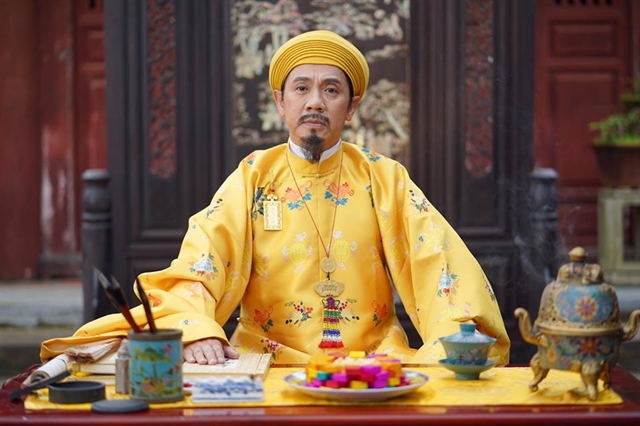
|
| Meritorious Artist Thành Lộc portrays King Thiệu Trị in Phượng Khấu. Traditionally, yellow was worn by the King and Queen Mother only. Photo courtesy of Huỳnh Tuấn Anh |
Costume designer Nguyễn Đức Lộc and his fellow workers at Ỷ Vân Hiên Company took responsibility for all the costumes in the series. Consulting with researchers, they designed the costumes to be as historically accurate as possible.
At the time, royal costumes were much more complicated than the áo dài (traditional long robe) worn today. Members of the royal family wore different styles and colours of outfits depending on their levels. For example, the yellow dress was reserved for the King and Queen Mother only. The Queen (the King’s crowned wife) wore red and red-orange dresses. Other concubines dressed in purple, blue and green.
Popular dresses included áo nhật bình, a casual item for female members of the royal family. “Nhật” means rectangle, referring to the shape the garment makes around the neck area where the robe is buttoned. Five bands of colours at the hem of the sleeves represented the five elements in traditional Vietnamese culture – metal, wood, water, fire and earth.
The designers also created sophisticated accessories such as necklaces, mấn (headdresses) and badges made of bronze and trimmed with gold and silver.
“Royal costumes gather the best of the artistic sense, skilful handicraft and intellectual talent of the artisans; they represent the quintessence of art and culture of that era,” said Đức Lộc.
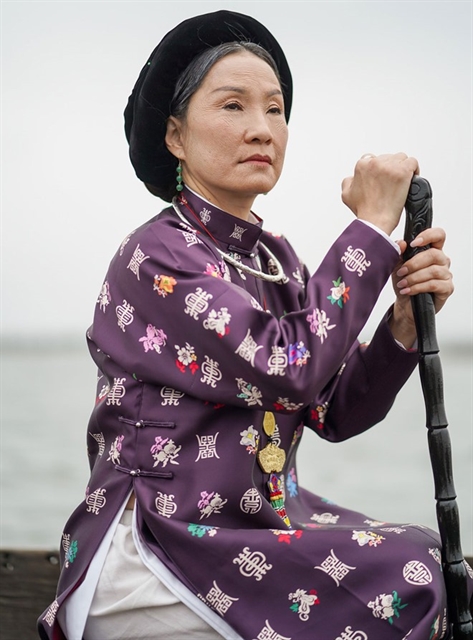
|
| Meritorious Artist Hồng Đào from a scene in Phượng Khấu. The series features various types of royal costumes including casual wear like this outfit. Photo courtesy of Huỳnh Tuấn Anh |
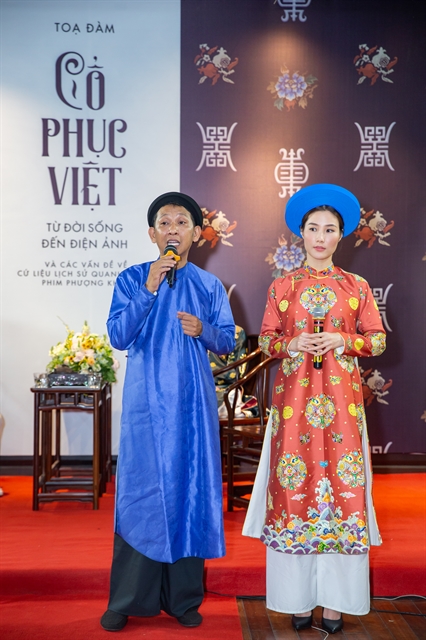
|
| Director Huỳnh Tuấn Anh (left) and actress Diễm My speak at the seminar on Vietnamese traditional costumes. VNS Photo Hà Phương |
“That’s why the process of designing and making them required so much time, effort and money."
“We used various types of fabric to make the costumes for the series since the characters have different classes," Đức Lộc said. "Some kinds were imported from Thailand, China and South Korea. Some were made in craft villages in the country where people have preserved the traditional trade of weaving silk such as Vạn Phúc, La Khê, Nha Xá, Mã Châu, Bảo Lộc and Mỹ A.”
Many people have argued that authentic Vietnamese clothes should be made from Vietnamese materials. But in reality, people have long imported fabric from foreign countries. This is not unique to Việt Nam; even Japanese people bought Vietnamese silk to make kimonos.
“No matter what kind of fabric is used, authentic Vietnamese outfits should be made by Vietnamese artisans with traditional techniques,” Đức Lộc said.
The designers experimented with many different styles and fabrics before settling on the final costumes for Phượng Khấu.
“We didn't perfectly reproduce the traditional royal costumes, because that would require too much time and effort as well as the involvement of historians and experts," Đức Lộc said.
"We just tried to make the costumes as similar to the ones in history as possible.
“Costumes for a film should match the context, sequences and characters,” Lộc".
Director Anh agreed, saying that the film crew was taking their work seriously.
“It may cause arguments around the film’s content and costumes, but we tried our best and we are willing to hear any idea or comment from audiences and researchers,” he said.
Each 60-minute episode of Phượng Khấu cost VNĐ2 billion (US$85,400), with half of the budget going towards costumes.
“People asked me why I invested much in costumes,” Anh said. “Firstly, Phượng Khấu is not only an entertainment product, it has a mission to preserve and promote Vietnamese traditional culture and history through the language of cinematography. We should show respect and seriousness when we talk about history.
“Secondly, I believe costumes express the quintessence and uniqueness of the culture and art of the Nguyễn Dynasty.
“Finally, I focused on creating costumes because the audiences love to see how beautiful and radiant the dresses are, unlike the ones they see in old monochrome photos. They are curious about how queens dressed in the past.”
Historian Lê Văn Lan praised the initiative and effort of the film crew. He recognised that Phượng Khấu is the first film to depict traditional royal costumes in a truthful and lively manner.
“The filmmakers were intelligent in selecting the context and time for the film because documents about royal costumes under the Nguyễn Dynasty are easier to find than for many dynasties in history,” Lan said.
“It’s not easy to reproduce old clothes in this setting because they must be truthful to history but still meet the aesthetic demands of the film.”
Dress it up
In recent years, Ỷ Vân Hiên Company has forged a reputation for reproducing traditional costumes and accessories.
Costume designer Đức Lộc's ambitious vision is to make the clothes common for daily activities beyond just festivals and fashion shows.
“I’m so happy that more and more people including men are electing to wear traditional long robes for special events," he said. "The clothes we made have their new lives, not only for the performances.”
Early this month, a seminar in Hà Nội discussed the preservation and restoration of royal costumes. The costumes used in Phượng Khấu were displayed to the public. People were impressed by the intricate, sophisticated hand-embroidered patterns of phoenixes, dragons, flowers, waves and clouds.
Ỷ Vân Hiên’s products, as well as costumes and accessories dating back to the Nguyễn Dynasty, were also on display. The highlight of the exhibition was the nhật bình dress of Princess Mỹ Lương, sister of King Thành Thái (1879-1954). It became a part of Ỷ Vân Hiên’s collection after an auction in the US.
At the event, 29-year-old actress Diễm My presented an outfit worn by Queen Lệ Thiên Anh (who she portrays) in the series. She received compliments from experts, especially Lady Công Tôn Nữ Trí Huệ, a descendant of King Minh Mạng (1791-1841).
“You are graceful in this beautiful dress. I see the manner and elegance of a noble woman in you,” she told My.
“The costume is beautiful, too," she said. "I realise that it’s like the original ones in form, colour, decorations and materials."
Lady Huệ is one of the last master artisans of making royal costumes. She still consults with Đức Lộc about how to reproduce dresses and accessories.
“I’m quite young in comparison with the cast of Phượng Khấu," My said. "It’s my good fortune to have a chance to star in this important film project."
“Taking part in a historical film brings both pressure and joy," she said. "In the dress of Queen Lệ Thiên Anh, I have to practise the behaviour, gestures and language of a noblewoman.
“Now I am more willing to wear traditional dress for special events; they are beautiful and sophisticated. I feel proud to wear them.
“Instead of Western-style suits, I also see many men wearing traditional long robes nowadays. They are not only part of the past. They are becoming part of the present.” VNS

